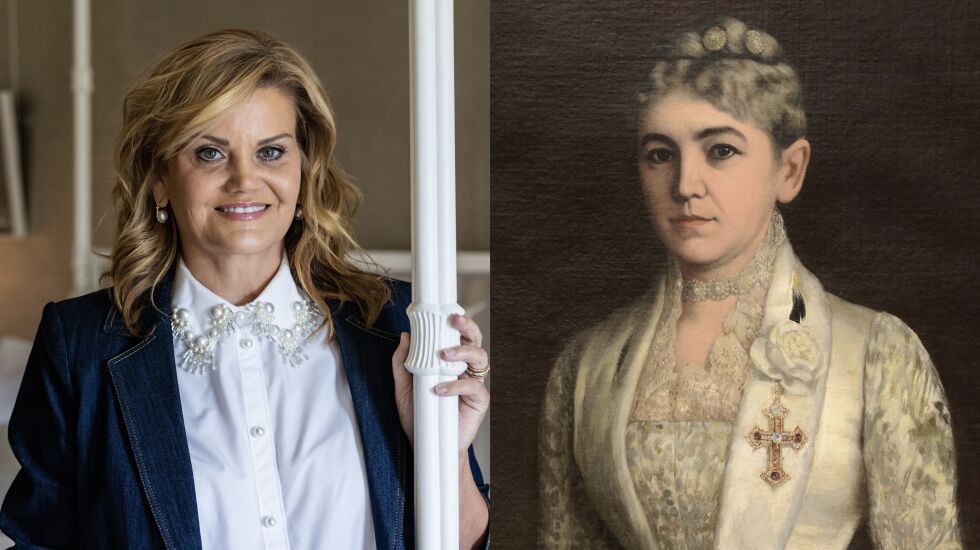Hmmm.
A portrait of painted cows to the right of me?
A flotilla of Mississippi Mud bluegill fish pottery to my left?
A whopper of a wackadoodle painting by Karl Wirsum, a member of Chicago’s Hairy Who group of artists peeking around the corner?
Surely that can’t be the Growing Flowing sculpture by Richard Hunt, the first Black American sculptor to be the subject of a solo exhibit at New York’s Museum of Modern Art.
Where in the heck am I?
Here’s where: checking out the quietly elegant, Illinois artist-infused, dreamily redecorated governor’s mansion in Springfield — before sipping a cup of soup in the dining room with uber refurbisher and Illinois first lady M.K. Pritzker.
The first lady had just taken me on a personal tour of the nation’s largest governor’s mansion, dropping historic tittle tattle along the way.
Later, in an exclusive interview, Pritzker discussed the book she has written about the mansion’s legacy titled “A House that Made History.” Proceeds from the sale of the lush Rizzoli publication, which is due out soon, are earmarked for the mansion’s future upkeep.

“I was home with the kids during COVID,” she said. “So I got busy and wrote the book.”
It’s the M.K. way.
Translation: Tackling work and a social schedule on steroids as the wife of Gov. J.B. Pritzker, Dem political powerhouse and billionaire scion of the Hyatt Hotel dynasty, is no mean job for Mary Kathryn (nee Muenster) Pritzker from Sioux Falls, South Dakota — known for her speed in getting things done without seeking a whole lot of publicity.

The first lady’s coffee table book is a luxurious 272-page compendium of the mansion’s lore, family life, famous visitors, furnishings, architectural history, tall tales, good vibes, bad plumbing and scary moments during the tenure of 43 gubernatorial administrations since it was built in 1855.
“It wasn’t long before I felt roped into these stories,” Pritzker said. “And then I was afraid they’d get lost to history if I didn’t tell them.
“After all, it is the people’s house … and the people of Illinois who elected leaders of the first state to pass the 13th Amendment abolishing slavery — and the 19th Amendment granting women the right to vote.”
Thus began the first lady’s treasure hunt for original architectural drawings and old rotogravure photos housed in forgotten nooks and crannies.
“We needed accurate historical content,” said Pritzker, who studied historic preservation at the Art Institute.
Surprisingly, she found some vintage photographs stuffed in a closet at the Illinois State Police’s office at the mansion.

For decades, the governor’s mansion was a malodorous house whose occupants constantly complained of ill health and “foul odor” due to poor plumbing, underground water, cranky boilers, leaking ceilings and electricity that couldn’t be trusted.
“It was a nightmare,” the first lady said. “The house had stories to tell and I, quite simply, wanted to tell them.”
Here’s a sampling:
- The first lady of ermine and rubies: Emma Gillett Keays Oglesby, the second wife of Gov. Richard J. Oglesby (1885-1889), was the daughter of a rich cattle baron who admired everything English. Thus, she posed for a house portrait wearing a silk and satin coat trimmed with ermine, known as a sign of power, enhanced with a ruby-encrusted cross in the fashion of English royalty. Her three sons also were painted wearing lace collars, natch.
- The man with a gun: African American Clarence Liggins, much-beloved chauffeur and jack of all trades to numerous Springfield pols, was granted refuge at the mansion during the Springfield race riot in 1908, armed with a walking cane designed to shoot a bullet.

- The death bed: Gov. William H. Bissell (1857-60), the state’s first Republican governor and first governor to die in the mansion, was comforted bedside to the end by his best friend Abraham Lincoln a year before Lincoln became president. Bissell’s niece Mary Kinney once locked Lincoln and her father out of the mansion into front-porch exile until they promised her “the best sack of candy that could be purchased in Springfield.”
- Give and take: Gov. John Wood (1860-61), Bissell’s lieutenant governor and successor until the next election, permitted Bissell’s wife and children to remain in the mansion for the year left of Bissell’s term after his death — leaving his own family behind in downstate Quincy. Wood died bankrupt.
- The color palette: In 1889, the red-brick mansion was painted a light stone color to recall the exterior of the White House, but it was restored to its original red in 1971 during Gov. Richard Ogilvie’s administration.

- Yikes! Gov. Joseph Fifer (1889-1893) was concerned about the appearance of partisanship after approving appropriations to repair the derelict mansion. So he appointed three commissioners to oversee the work: a Springfield businessman, a hotel operator and a newsman rumored to be a Democrat.
- See you later, alligator! Gov. Fifer’s young daughter Florence kept an alligator in the porch fountain, rode her pony up the mansion’s front steps and slid down the banister of the mansion’s elliptical staircase during her father’s inaugural festivities — and became a political force in her own right, the first woman to be elected to the Illinois House of Representatives.
- Welcome to the party! Popular Gov. William G. Stratton (1953-1961) and first lady Dorothy Breckenridge Stratton entertained at the mansion more than any previous governor — 25,000 guests each year in his first term of office. They transformed the mansion office into a family game room for pingpong and shuffleboard.

So let’s cut to the chase. “Is the mansion haunted?”
“Let’s put it this way,” M.K. said with a chuckle. “We found no evidence of anyone officially reporting they had seen the alleged ghost whispered of as first lady Catherine Geers Yates.”
That would be the widow of Civil War Gov. Richard Yates Sr. Honored as “The Soldier’s Friend,” he was known to weep in the hallways every time news of war dead were reported to him on “telegram nights.”
“And, of course, we have not seen HER on our watch,” said M.K.

The ghost query was prompted by my one-night stay at the mansion years ago in the wallpaper-tattered, water-stained antebellum red Children’s Room, now renamed the Chicago Room, located across from the Lincoln Bedroom. I’d been awakened at midnight by a mysterious series of scrapes and knocks at my door.
“Oh, Mike, that was George!” chirped then-first lady Lura Lynn Ryan the next morning, referring to her husband, Gov. George Ryan, who was pranking Sneed.
Major mansion reconstruction was completed during the tenure of Gov. Bruce Rauner (2015-19) and his wife Diana Mendley Rauner.
“Diana Rauner gave me the canvas to decorate,” Pritzker said. “I guess you could say she handed me a cake, and I was able to add frosting. I am so grateful to her for that.”
While writing the book, Pritzker also led an army that included world-class interior decorator Michael Smith, who helped decorate the Obama White House, to repaint, replaster and redecorate the entire mansion, turning it into “a house of quiet luxury.”
“Nothing austere or cold in this house,” said M.K., who described Smith’s decorating touch as “a warm hug,” and whose legacy book is filled with photos of the mansion’s transformation into parlor walls swathed in “calming” custom-made blue and green silk moire, historic Zuber Cie and cornstalk wallpaper and expensively covered “comfortable” furniture.

During the remodeling phase, M.K. Pritzker also purchased and donated to the mansion a gilded, circa 1815 Baltimore Pier table originally purchased in the 1870s by a wealthy Chicago woman as a donation to a new “Illinois Room” at George Washington’s newly renovated home in Mount Vernon.
A rare portrait of an unbearded Lincoln now hovers over the Honduran mahogany table.
“This house is my gift to the people of Illinois,” Pritzker said. ”After all, this is their house; a present from the present to the future.”
Much historical Illinois furniture still remains in the Springfield mansion, including marquetry master Peter Glass’s 1864 table crafted for Lincoln and said to contain black walnut fence rails split by the 16th president, and the famous William J. Bartels (1848-1932) furniture hand carved in Illinois wood secured by Gov. “Big” Jim Thompson’s (1977-1991) administration.

A footnote: Lincoln — who had said, “I expect to go back and make my home in Springfield for the rest of my life” — was assassinated while plans were afoot by close friends to purchase a house for him across the street from the mansion.
Lastly, Gov. J.B. Pritzker’s mansion office contains a painting of the state’s first Jewish governor, the hugely popular and unmarried Henry Horner, who populated the mansion with remarkable dogs and whose vast collection of Lincoln memorabilia became the cornerstone of Springfield’s Lincoln Library.
So it’s no surprise the mansion is still filled with many portraits and references to Lincoln.
And, yes, the Pritzker’s beloved family dog is also named … Lincoln.








